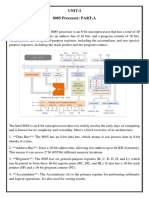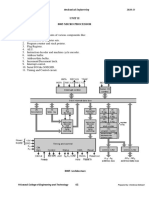Early Microcomputer Design
Early Microcomputer Design
Uploaded by
Rey DumpitCopyright:
Available Formats
Early Microcomputer Design
Early Microcomputer Design
Uploaded by
Rey DumpitCopyright
Available Formats
Share this document
Did you find this document useful?
Is this content inappropriate?
Copyright:
Available Formats
Early Microcomputer Design
Early Microcomputer Design
Uploaded by
Rey DumpitCopyright:
Available Formats
Early Microcomputer Design
SAP1 (Simple-As-Possible) Architecture The SAP1 architecture is 8 bits and comprises of 16x8 memory, that is memory location with 8 bits in each location,therefore, need 4 address lines which either comes from the Program Counter during computer run phase or comes from the four address switches during the program phase. SAP can only perform addition and subtraction and no logical operation. SAP1 has a W-Bus, a single 8 bit bus for address and data transfer. SAP1 explains how a microprocessor works, how instructions are being process and executed and how it interacts with memory and input and output. SAP1 Architecture 1. Program Counter (PC) - It sends the address of the next instruction to the memory that will be fetched and executed. 2. Input and MAR - include the address and switch registers. The switch registers allows to send an address bits to the RAM. 3. RAM - allows you to store data in memory before a computer/program runs. 4. Instruction Registers (IR) - part of the control unit that contains the instruction to be executed. 5. Controller Sequencer - control the operation of the computer. 6. Accumulator - is a buffer register that store intermediate result of computer operation. 7. Adder/Subtracter - is a 2's complement adder/subtracter. 8. B-Register - a buffer register used in arithmetic operation. 9. Output Register - contain the result of operation. 10. Binary Display - row of 8 bit LED, that shows the output. SAP1 has six T-states(Timing states), three fetch and three execute cycles, for each instruction. T1, T2, T3 cycle are use for fetch cycle and T4, T5, T6 cycle are use for execute cycles. And those unused T-states will be considered as NOP(no operation) cycle.
You might also like
- Simple As Possible ComputerDocument13 pagesSimple As Possible ComputerMd Raton AliNo ratings yet
- Sap PresentationDocument27 pagesSap PresentationPreeti SharmaNo ratings yet
- Sap Part1Document22 pagesSap Part1Md.Rakibul IslamNo ratings yet
- Group 4 Sap-1 Arch CaoDocument6 pagesGroup 4 Sap-1 Arch Caotantiana parangNo ratings yet
- Architecture of 8085 MicroprocessorDocument69 pagesArchitecture of 8085 Microprocessornamrata puranikNo ratings yet
- Simple As Possible Computer (SAP-1) : Lecture-3Document44 pagesSimple As Possible Computer (SAP-1) : Lecture-3Tawhid KhondakarNo ratings yet
- Exp - 1Document7 pagesExp - 1rk5336222No ratings yet
- Computer Organization, Architecture and Machine Level ProgrammingDocument17 pagesComputer Organization, Architecture and Machine Level ProgrammingJaysen GeronimoNo ratings yet
- The 8085 Microprocessor ArchitectureDocument12 pagesThe 8085 Microprocessor ArchitectureBernard MunyithyaNo ratings yet
- Simple-As-Possible 1 (SAP-1) Architecture: A Block DiagramDocument8 pagesSimple-As-Possible 1 (SAP-1) Architecture: A Block DiagramLeonel ElinonNo ratings yet
- Part 2 Chapter 1Document26 pagesPart 2 Chapter 1zor123oooNo ratings yet
- 8085 MicroprocessorDocument20 pages8085 Microprocessorjeravi84No ratings yet
- Microprocessors and Microcontrollers NotesDocument293 pagesMicroprocessors and Microcontrollers NotesKumar ChaitanyaNo ratings yet
- MPC 2Document29 pagesMPC 2rohit sharmaNo ratings yet
- 8085 MicroprocessorDocument25 pages8085 Microprocessorprofessor2062No ratings yet
- Computer 1 File Final-1Document36 pagesComputer 1 File Final-1Priyanshu GuptaNo ratings yet
- 1 8085 Microprocessor ArchitectureDocument7 pages1 8085 Microprocessor Architecturejosrichman75No ratings yet
- Up TKM AnzDocument31 pagesUp TKM AnzansalvNo ratings yet
- Unit 2 MicroprocessorDocument46 pagesUnit 2 MicroprocessorHARSHITANo ratings yet
- Unit I The 8086 MicroprocessorDocument21 pagesUnit I The 8086 Microprocessor16211a0470100% (1)
- Chapter 1Document16 pagesChapter 1ZAIEEM KHANNo ratings yet
- SAP1 Architecture and Early Computer DesignDocument3 pagesSAP1 Architecture and Early Computer DesignTol Man Shrestha0% (1)
- CSC 503 - Microprocessor and Microcomputer Theory 2Document12 pagesCSC 503 - Microprocessor and Microcomputer Theory 2edocharles728No ratings yet
- Unit 1 - The Intel Microprocessors 8086 ArchitectureDocument18 pagesUnit 1 - The Intel Microprocessors 8086 Architecturenareshshende.amritNo ratings yet
- Coa PR-2Document10 pagesCoa PR-2tovev86979No ratings yet
- MP LectureNote1 4Document30 pagesMP LectureNote1 4Yoseph ChalieNo ratings yet
- Architecture Diagram of 8085 MicroprocessorDocument4 pagesArchitecture Diagram of 8085 MicroprocessorbhatiaharryjassiNo ratings yet
- L-3 8 Bits MicroprocessorDocument12 pagesL-3 8 Bits Microprocessormuhamed.abdelhamid16No ratings yet
- Questionnaire MICROPROCESSOR PART 1 UNIT 1 and 2Document20 pagesQuestionnaire MICROPROCESSOR PART 1 UNIT 1 and 2aditya2021cs081No ratings yet
- UNIT I MicroprocessorDocument130 pagesUNIT I MicroprocessorAlok KumarNo ratings yet
- 1-Architecture of 8085Document34 pages1-Architecture of 8085Pinki KumariNo ratings yet
- MPMC Module 1Document23 pagesMPMC Module 1vivekNo ratings yet
- MICROPORCESSOR 8085 Lab ManualDocument53 pagesMICROPORCESSOR 8085 Lab ManualAjay PatilNo ratings yet
- FMM Unit-1Document28 pagesFMM Unit-1CS ENo ratings yet
- 8 Bit General Purpose MicroprocessorDocument4 pages8 Bit General Purpose MicroprocessorraushanNo ratings yet
- EE6502 Microprocessors and MicrocontrollersDocument66 pagesEE6502 Microprocessors and Microcontrollerssonu sabooNo ratings yet
- MPMC Unit 2Document31 pagesMPMC Unit 2nikitaNo ratings yet
- Part 2Document41 pagesPart 2ah chongNo ratings yet
- MicroprocessorsDocument11 pagesMicroprocessors158 AshleshaNo ratings yet
- Unit Iii MicroprocessorsDocument31 pagesUnit Iii MicroprocessorssubendNo ratings yet
- 8085 Note Final - 2Document35 pages8085 Note Final - 2durgaprasadNo ratings yet
- 8085 Is Pronounced AsDocument9 pages8085 Is Pronounced AsArbaaz khan786No ratings yet
- 8085Document47 pages8085Govind GuptaNo ratings yet
- Unit I BCADocument11 pagesUnit I BCAhb2202099No ratings yet
- Tutorial On Introduction To 8085 Architecture and ProgrammingDocument23 pagesTutorial On Introduction To 8085 Architecture and ProgrammingKorak MitraNo ratings yet
- 1 Architecture of 8051 Microcontroller PDFDocument18 pages1 Architecture of 8051 Microcontroller PDFPavin Ka85% (68)
- Architecture of 8085Document7 pagesArchitecture of 8085Rucha GhareNo ratings yet
- Embedded Microprocessor Lecture 2Document15 pagesEmbedded Microprocessor Lecture 2ojasbhosale07No ratings yet
- Experiment 1 4 SemesterDocument6 pagesExperiment 1 4 Semesteraman YadavNo ratings yet
- 8085 Microprocessor ArchitectureDocument3 pages8085 Microprocessor Architecturetguna21No ratings yet
- MCT Unit 2Document26 pagesMCT Unit 2Aravind RajNo ratings yet
- Experiment No: 1: OBJECTIVE: To Study About The Bus Organization and Programmable Model ofDocument5 pagesExperiment No: 1: OBJECTIVE: To Study About The Bus Organization and Programmable Model ofRutul PrajapatiNo ratings yet
- UNIT - 3 MicroDocument14 pagesUNIT - 3 Microasha.py81No ratings yet
- Microsad Q2Document66 pagesMicrosad Q2John Railey P. PamintuanNo ratings yet
- 6800Document11 pages6800Nikola PetrovićNo ratings yet
- 8085 ArchitectureDocument10 pages8085 Architectureitssam4577No ratings yet
- MPMC Eee Unit - III 8051 MicrocontrollerDocument35 pagesMPMC Eee Unit - III 8051 MicrocontrollerAnonymous 4u5XkWGONo ratings yet
- Class 2-Introduction To 8085 Microprocessor PDFDocument46 pagesClass 2-Introduction To 8085 Microprocessor PDFDeepika AgrawalNo ratings yet
- MICROCOMPUTERDocument12 pagesMICROCOMPUTERneshmuneneeNo ratings yet
- Preliminary Specifications: Programmed Data Processor Model Three (PDP-3) October, 1960From EverandPreliminary Specifications: Programmed Data Processor Model Three (PDP-3) October, 1960No ratings yet
- Test Yoursel1Document5 pagesTest Yoursel1Rey DumpitNo ratings yet
- School FormsDocument36 pagesSchool FormsFranco Evale YumulNo ratings yet
- Summary On The Selection of Honor Pupils: Ramada Elementary SchoolDocument2 pagesSummary On The Selection of Honor Pupils: Ramada Elementary SchoolRey DumpitNo ratings yet
- Nat Review Vi Narrative Report: Ramada Elementary SchoolDocument2 pagesNat Review Vi Narrative Report: Ramada Elementary SchoolRey DumpitNo ratings yet
- List of Nat ExamineesDocument1 pageList of Nat ExamineesRey DumpitNo ratings yet
- Classroom ProgramDocument2 pagesClassroom ProgramRey DumpitNo ratings yet
- Kinds of Informal ReportDocument2 pagesKinds of Informal ReportRey Dumpit100% (2)
- Eading AND Writing Money ValuesDocument35 pagesEading AND Writing Money ValuesRey DumpitNo ratings yet
- Reinstatement of DutyDocument2 pagesReinstatement of DutyRey DumpitNo ratings yet
- All Kinds of OSDocument11 pagesAll Kinds of OSRey Dumpit100% (1)
- Timeline AMDDocument6 pagesTimeline AMDRey DumpitNo ratings yet
- GUARANTY - An Agreement by Which One Person: ReportersDocument3 pagesGUARANTY - An Agreement by Which One Person: ReportersRey DumpitNo ratings yet
- Reasons For DeadlockDocument2 pagesReasons For DeadlockRey DumpitNo ratings yet
- Early Registration FormDocument1 pageEarly Registration FormRey DumpitNo ratings yet
- Accomplishment Report in Math, 2010-2011Document3 pagesAccomplishment Report in Math, 2010-2011Rey Dumpit71% (7)
- Date Name OR# CBU PS GF DamayanDocument302 pagesDate Name OR# CBU PS GF DamayanRey DumpitNo ratings yet











































































